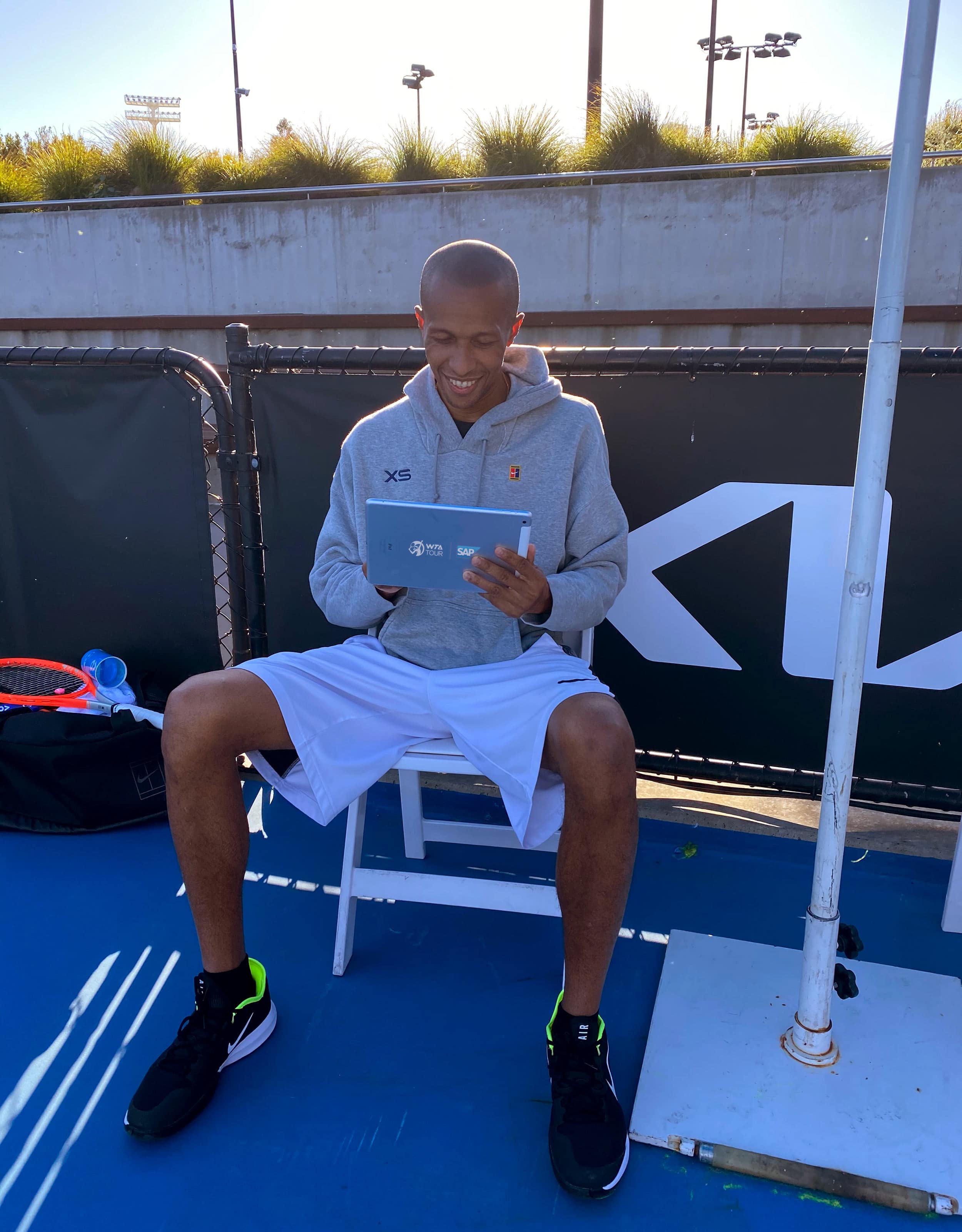Ahead of next week’s Australian Open, SAP is thrilled to partner with Kamau Murray, the brand’s newest tennis ambassador. Murray has had an incredible journey to become one of the top coaches in the Women’s Tennis Association (WTA) today.
Growing up in Chicago, Murray was an active participant in Chicago Park District tennis programs, learning firsthand the value of introducing athletics at an early age to instill sportsmanship, strong work ethics, self-confidence, and peer interaction, along with other important life lessons. He excelled in this environment and was subsequently offered a full scholarship to play tennis at Florida A&M University.
In 2004, Murray returned to his early roots by offering tennis lessons to children. He knew that there was a continued need for a program within local communities.
Four years later, he became the founder of XS Tennis and Education Foundation. Today, XS Tennis continues to transform many lives by combining Murray’s passions for tennis and education. Murray’s initial five students have gone on to win national championships, IHSA state championships, and two Junior Olympic Gold medals, while 100% of the program’s graduating seniors have received college tennis scholarships to top universities.

Murray’s community work and reputation for growing youth into top college tennis players later caught the attention of rising star Sloane Stephens, which created a new path for him to become a WTA coach. In 2017, Murray coached Stephens to an historic US Open title, where he become only the third African American coach to win a grand slam in its 95-year history.
To celebrate the start of this new partnership, SAP caught up with Kamau Murray to discuss his passion for tennis, his experiences coaching Sloane Stephens, and the importance of technology and analytics in today’s game.
Q: You started playing tennis at the early age of seven in the inner city of Chicago. Can you tell us what motivated you to pick up the racket and play?
A: In 1998, my parents took 20 youth to Africa for a cultural exchange program. When we returned to the United States, all the summer camps and programs were full and not accepting students. My godfather was an avid tennis player and told my mom that the camp at Jesse Owens Park was still accepting. My mom quickly drove by the park to inquire. She asked the coach what the cost was for the rest of the summer. When the coach told her it was only $12, I remember her quickly turning around and saying, “Boy get out of the car.”
Once I got a taste of the game that summer, I became hooked and continued playing five days a week during the school year. From that point on, tennis became a major part of my life and provided me with a unique identity.
You certainly are driven on and off the court. In 2005, you founded the XS Tennis program to help Chicago’s underserved youth through a community-based academic, sports enrichment program. What is your biggest accomplishment thus far with the XS program?
By far our biggest accomplishment is the students who have gone on to earn tennis scholarships to college. I witnessed firsthand the impact a college education can have on children in urban communities. I also understand that once you get on campus it’s hard to stay there.
When a student earns a scholarship, they gain access to all the benefits that come with that, including free tutoring, a coach, and an athletic department that monitors graduation rates and GPAs. That support system is critical. To date, more than 55 students from XS have been able to play tennis at the collegiate level with access to a strong support system.
In addition to our students playing tennis in college, we have also touched the lives of more than 1,000 students for four years in a row. There are more youth playing tennis on the south side of Chicago than ever before. I strongly believe that for tennis to grow globally, the growth needs to come from the minority community specifically. It’s our greatest challenge, but it’s also our biggest opportunity.
This isn’t your first-time coaching Sloane. What makes your partnership so special on and off the court?
I think the key to any successful partnership is trust on and off the court. My partnership with Sloane got off to a great start in 2016 when she won three tournaments in four months. Previously she had only won one title in her career.
I witnessed how tough she was and how well she handled the pressure in those finals. I also saw her ability to execute a plan, at times where a lot of players just revert to their lifelong tendencies. Those three quick titles allowed me to gain her trust a lot sooner than expected. Sloane knows that any advice or coaching I provide is well informed.
What has kept us together for so long is our ability to make the work and the travel fun. Tennis has the longest season of any sport, so if you don’t like the person, you will not be able to stand each other for 32 weeks of the year.
What is your overall view of technology innovation in sport and more specifically in tennis? In the future, what technology would help you even more as a coach?
The use of “in-game” technology and immediate feedback allows tennis players to adjust quicker, creating closer matches, which ultimately makes our sport more fun to watch. On the women’s side, you now see a lot of coaches using tablets and stats on the sideline. If you couple that with the allowed on-court coaching visits, we are seeing a lot of younger players having success earlier because they are now able to access coaching that closes the gap between them and the veteran opponents on the other side of the net. That can be 100% attributed to the immediate value from technology and statistics. It has created a few unlikely champions. The other part of this is that the veteran players who have played a lot of matches on big stadium courts equipped with all the cameras and technology have more data points for the younger players to study.
From a training perspective, technology has taken a lot of the guesswork away. Historically, players would condition their bodies to get in good general shape without knowing exactly what that means. Now, the data can tell you how many miles are run during a match and how many feet are run during an average point so you can train your body to perform at that level in a more precise fashion.
In post-match coaching situations, technology makes these conversations easier for both parties. In the past, the player says: “I feel I did this,” and the coach says: “I feel like you did that” — oftentimes resulting in a back-and-forth dialogue that lasts well into the next day. Now, SAP data is available immediately and by the time the player gets done showering, the conversation and adjustments will be based on fact, and less on feelings.
What’s next on the horizon for you?
In 2021, my primary goal is to help Sloane return to the top 20. Innovation doesn’t only come in the form of technology. Players also must innovate and develop new skills to change alongside a sport that changes every six months. From year to year, the rackets are becoming more powerful, the balls are getting heavier, strings are creating more spin. My goal this year is to continue to add little innovations to Sloane’s game.
Secondly, as an SAP ambassador, my goal is to continue to innovate with the WTA and SAP to increase usage of data insights available to all players and coaches.
I am thrilled to work more closely with the WTA to continue to make the game more accessible and more attractive, and to reach a broader audience. They say the tide rises all ships. The more we can grow the participation and popularity of the sport, the better it becomes for everyone.
Bonnie Rothenstein is vice president of Global Sponsorships at SAP.



